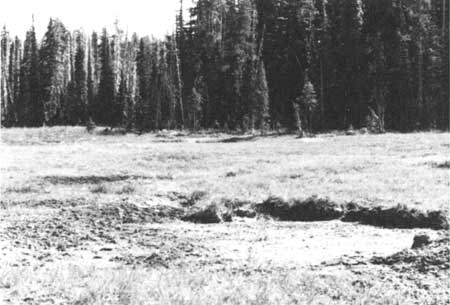An elk wallow on the south end of Sphagnum Bog. Empty clam shells could be found all over the surrounding area. During wet periods, the clams probably crawled where they pleased. The wallow was the only source of water for several yards in any direction during the drought of 1992 (when this picture was taken).
Further Study Needed
In a recent survey of the ponds in Crater Lake National Park, clams were found in almost every pond in the park. These clam populations reflect the historic use of the ponds by birds and elk. More information is needed about their role in the park’s food chain and how populations of larger animals are affected by the distribution of clams. No less important, however, is the fact that these clams are a subtle reminder of the many mysteries that wait to be discovered throughout the park.
Crater Lake…Unique?
The word “unique” is slippery. If defined as meaning “one of a kind,” we must answer the question, “One of what kind?” Although “unique” is commonly used in our language, it can become trite the more we consider what it is describing. After all, isn’t everything in some way unique?
Many people ask “Are there any other lakes in the world like Crater Lake?” The answer usually surprises them. It often disappoints as well. Typically, I answer “Plenty. ”
Considering that Crater Lake was formed by a volcanic collapse, one wouldn’t expect this answer. Most believe that any big hole inside a volcano has resulted from an enormous blast. Few have ever heard of a volcano collapsing.
Volcanoes sometimes collapse. The results of such events are calderas, which are found in volcanic regions throughout the world. It is also fairly common for calderas to fill with water and form lakes. Examples are found in Japan, Greece, Peru, Sudan, New Zealand, and many other countries around the globe. Here in the western United States, one of our best known examples is Yellowstone Lake, which partially resides in the Yellowstone Caldera–a depression over 25 miles across.
Closer to Crater Lake, in the Cascade Range, there are also many caldera lakes. To the south of the park is the Mountain Lakes Wilderness Area. Many of the lakes found there resulted from a large caldera collapse followed by later glacial activity. The glacial sculpting tells us that the Mountain Lakes caldera is easily older than 10,000 years, which marked the terminus of the last ice age.
Not far to the north of Crater Lake, we can find Paulina and East Lake at Newberry Volcanic National Monument. These two lakes are found within the Newberry caldera which collapsed about 500,000 years ago. (This was about the same time that Mount Mazama, Crater Lake’s volcano, began to form). What’s more, Newberry shows evidence that it has collapsed several times, leaving a series of “nested” calderas.
Perhaps our most intriguing caldera lake can be found in another national park far from Crater Lake. Katmai National Park in Alaska is the home to Katmai Peak, which had a huge caldera-forming eruption in 1912. This same eruption formed the famed Valley of Ten Thousand Smokes. The destroyed summit of Katmai Peak is now a depression of roughly one-half the diameter of Oregon’s Crater Lake. Since the collapse, Katmai’s caldera has been slowly filling with water. Naturally, the developing body of water has been aptly named Crater Lake.
Alaska has another caldera that is even more fascinating, though it is mostly “dry bottomed. ” An eruption 3,500 years ago created Aniakchak, a six mile wide, 2500 foot deep caldera that is remarkably similar to Crater Lake in size and age. The caldera has many post-collapse volcanic features, including a peak very similar to Crater Lake’s Wizard Island. In addition, study reveals that many of the post-collapse eruptions actually occurred underwater. This tells us that Aniakchak once had a deep caldera lake that would have been remarkably like Crater Lake-complete with its own Wizard Island! The lake is gone today, however, having left behind a 1,500 foot cut where the lake breached the side and eroded away the caldera wall.
Currently, the Aniakchak caldera contains a minute lake known as Surprise Lake, a two and one-half mile long remnant of Crater Lake’s former rival. Along the shoreline of this lake are many small springs–evidence that all is not quiet at Aniakchak. These springs may have once been active below the formerly larger lake, much like the springs currently found in the depths of Crater Lake.
So is there anything “unique” about Oregon’s Crater Lake? Is the world simply rife with Crater lakes?
Let us consider the lake’s non-geologic characteristics There are some that set Crater Lake apart from other lakes. Intensive research conducted over the past ten years revealed that Crater Lake has unsurpassed water clarity, record depths for aquatic species, and some organisms found nowhere else in the world. Certainly these aspects make Crater Lake unique, don’t they?
To a degree. Once again we run into problems with the concept of “unique”. Taking the water clarity as an example, it is true that Crater Lake holds the world record for clarity. But it is important to recognize that the clarity of Crater Lake, like that of all lakes, fluctuates.
John Salinas is a researcher whose work was instrumental in initiating the congressionally mandated, ten year research program at Crater Lake. At Oregon’s second deepest lake, Waldo Lake, Salinas recently obtained readings that indicated extremely high clarity, easily rivaling Crater Lake’s average clarity. Salinas took these readings at a time when Crater Lake’s clarity cycle was at a low–well below average. Therefore, on that given day, Waldo may have been the clearest lake in the world!
I personally dislike the word “unique”, as it seems to be an abysmally nebulous term. Truly, there is only one Mount Mazama, and within it is the world renowned Crater Lake. But in nature all things, including all lakes, are unique.
***previous***


